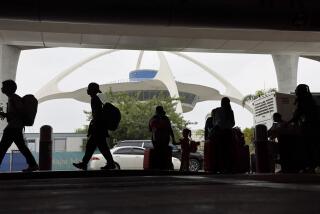Analysts Predict More Vacation Driving, But Shorter Trips Due to Rising Gas Prices
- Share via
Vacationers are expected to drive more this summer than last despite the recent jump in gasoline prices but will take shorter trips, according to travel industry groups.
Motor vehicles will account for nearly 83% of all summer travel, with 273 million vacationers expected to travel the nation’s roads and highways in the 14-week period between Memorial Day and Labor Day, a 4% increase over 1988.
“The sharp increases in gasoline prices since March, 1989, although higher than usual for the pre-summer travel season, are not expected to be a serious deterrent to auto vacation travel this summer,” according to the Washington-based U.S. Travel Data Center. The center’s data are based on a national telephone survey of 1,500 households.
Retail gasoline prices have risen an average of 17.4 cents a gallon since Easter weekend, the steepest rise between holidays since Christmas, 1979, and Easter, 1980, when prices jumped 19 cents a gallon, according to the American Automobile Assn.
The average retail cost of a gallon of gasoline is $1.254, with actual costs varying between cities, states and regions and self-serve or full-service stations.
Air travel is expected to remain relatively stable at last summer’s level, representing about 15% of all vacation travel, while bus and train travel, which represents 1%, is expected to be at capacity.
16% Increase
Airline fares increased far more than gasoline in the first quarter of 1989--6.2% compared with 2.5%--but second-quarter gas prices have leaped more than 16% due to a combination of factors, including the Alaska oil spill and the strong rise in crude oil prices since January, according to the AAA.
Overall summer vacation travel is expected to rise about 3% from last year, with vacationers generally opting for shorter trips, industry surveys indicate.
More than half of all summer travelers will make round trips of 500 miles or less, according to the AAA. Average domestic miles traveled are projected to decline to 920 from 970 last summer.
“America wants to travel more than ever and its people are going to satisfy this desire even if the demands of time and two-income families are forcing them to take three- and four-day trips in place of one- and two-week vacations,” said Suzanne Cook, director of the AAA data center.
According to the center’s survey, the volume of day trips and trips of up to three nights will rise 7% and make up more than half of all summer vacation travel.
Overall travel prices were up 4.5% during the first quarter of this year compared with last year, according to the data center. Transportation and lodging costs were up 4.1%, food and beverage costs up 4.6% and entertainment up 5.6%.
More to Read
Inside the business of entertainment
The Wide Shot brings you news, analysis and insights on everything from streaming wars to production — and what it all means for the future.
You may occasionally receive promotional content from the Los Angeles Times.










